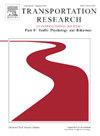利用集成认知架构预测驾驶员在紧急情况下的态势感知和响应时间
IF 3.5
2区 工程技术
Q1 PSYCHOLOGY, APPLIED
Transportation Research Part F-Traffic Psychology and Behaviour
Pub Date : 2025-07-09
DOI:10.1016/j.trf.2025.07.007
引用次数: 0
摘要
由于L3级自动驾驶允许驾驶员执行与驾驶无关的任务(NDRTs),因此有必要研究NDRTs对驾驶员行为的影响,以确保控制权的安全过渡。本研究旨在探讨不同资源需求的NDRTs下驾驶员的态势感知变化及其反应能力。重要的是,本研究提出了一种新的认知机制来完善不同NDRTs下的接管认知模型。此外,将时间压力作为一个潜在变量,表现为司机在接收请求(TOR)后SA恢复和接管策略的变化。采用排队网络自适应控制思维理性(QN-ACTR)认知架构构建了7个单任务模型。本研究利用QN-ACTR的多任务调度机制模拟多任务性能,将二者自然地结合成一个更复杂的接管模型。同时记录80名驾驶员的视觉行为和反应时间。实验结果表明,视觉资源需求显著损害驾驶员的SA恢复,延长接管决策时间。物理资源需求主要增加了驾驶员的运动准备时间和接管时间。相比之下,参与只需要认知资源的NDRTs使驾驶员在自动驾驶过程中保持警觉,并在TOR之后更快地做出反应。这些研究结果表明,中等认知资源需求水平的NDRTs可能更适合L3级自动驾驶。在模型适应度方面,TOR前后视觉行为的决定系数R2分别为0.96和0.94。反应时间的R2为0.98。该模型能很好地拟合人体数据。总体而言,本研究的建模方法和生成规则是驾驶员接管策略和技能的合理表征。该模型可用于解释不同NDRTs下驾驶员的认知机制。本文章由计算机程序翻译,如有差异,请以英文原文为准。
Predicting Drivers’ situation awareness and response times in the emergency situation using an integrated cognitive architecture
Because drivers are allowed to perform non-driving related tasks (NDRTs) in Level 3 (L3) automated driving, it is necessary to investigate the effects of NDRTs on driver behavior to ensure a safe transition of control. This study aims to examine drivers’ situation awareness (SA) changes and response abilities under NDRTs with different resource demands. Significantly, this study presents a novel cognitive mechanism to refine the takeover cognitive model under different NDRTs. Besides, time stress was considered as a latent variable manifested by the change in drivers’ SA recovery and takeover strategies after the takeover request (TOR). Seven single-task models were built using the Queuing Network-Adaptive Control of Thought Rational (QN-ACTR) cognitive architecture. The study combined them into a more complex takeover model naturally by utilizing the multi-task scheduling mechanism of QN-ACTR to simulate multi-tasking performance. Simultaneously, 80 drivers’ visual behavior and response time were recorded. The experiment results showed that visual resource demands significantly impaired drivers’ SA recovery and prolonged takeover decision time after the TOR. Physical resource demands primarily increased drivers’ motor readiness time and takeover time. In contrast, engaging in NDRTs that require only cognitive resources enabled drivers to remain alert during automated driving and respond more quickly after the TOR. These findings suggest that NDRTs with a moderate level of cognitive resource demand may be more appropriate for L3 automated driving. Regarding model fitness, coefficients of determination (R2) for visual behavior before and after the TOR were 0.96 and 0.94, respectively. R2 was 0.98 for the response time. The model could fit the human data well. Overall, the modeling method and production rules in this study are reasonable representations of drivers’ takeover strategies and skills. The model can be used to explain drivers’ cognitive mechanisms under different NDRTs.
求助全文
通过发布文献求助,成功后即可免费获取论文全文。
去求助
来源期刊
CiteScore
7.60
自引率
14.60%
发文量
239
审稿时长
71 days
期刊介绍:
Transportation Research Part F: Traffic Psychology and Behaviour focuses on the behavioural and psychological aspects of traffic and transport. The aim of the journal is to enhance theory development, improve the quality of empirical studies and to stimulate the application of research findings in practice. TRF provides a focus and a means of communication for the considerable amount of research activities that are now being carried out in this field. The journal provides a forum for transportation researchers, psychologists, ergonomists, engineers and policy-makers with an interest in traffic and transport psychology.

 求助内容:
求助内容: 应助结果提醒方式:
应助结果提醒方式:


